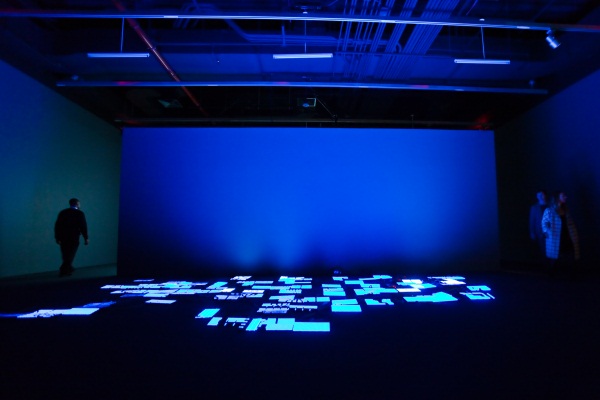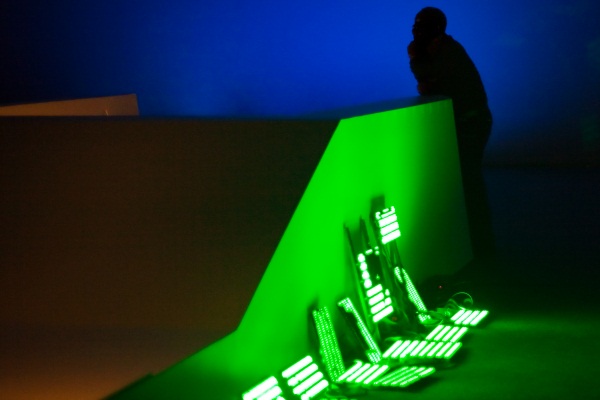Corroding the Machine
1. The Present
On the third floor of the Museum of the Moving Image right now you'll find an exhibit called "Street Digital," which includes, among other things:
- a mass of LED displays, turned horizontal, placed on the floor, set on the fritz, with lights going out and tracing strange patterns in the black of their absence
- a keyboard turned into skateboard hooked up to a Twitter account (step on the keys until, eventually, you hit ‘enter': a tweet!)
- four versions of the early video game Quake that have been rendered entirely abstract text fill one screen, violent slashes of black and white light another
- an omnium-gatherum of YouTube videos documenting charmingly innocent destruction.
What are these defiant objects and how did they get here?

From the exhibition JODI: Street Digital at the Museum of the Moving Image
2. Origins
Story (1)
Music can be a nuisance. Much in the way many of us are now annoyed by people texting at crosswalks or in movie theaters, the radio, as its presence spread in the first half of the 20th century, was experienced by some as intrusive, offering unwanted distraction from the simple sounds of the everyday.
The composer John Cage, who built a near-religion out of being attentive to quotidian humdrum, building new strategies for listening to the unstructured noise of life, was not necessarily fond of radios. People were being confronted everywhere with popular music: its irresistible hooks, thrumming repetitions, and familiar 4/4 time signatures, signaling when and exactly how to listen.
Cage's response was to incorporate radios into his compositions. In Imaginary Landscape No. 4 (March No. 2) (1951), he wrote a "score" for radios, assigning 24 people to 12 "instruments," one for changing stations and another controlling volume and tone. In Radio Music (1956), Cage layered eight radios, with the score determined by the kinds of chance operations he was exploring at the time. The pieces used the legible patterns of pop and the calming banter of talk radio as mere sonic elements within a disruptive cacophony. The hooks were there, along with the pat simplicities of advertising and corporate news, but these were now presented as swelling pitches and fading static: irreducible sound. This strategy had serious consequences for music, not just in the realm of experimental composition, but for popular musicians such as Brian Eno, Sonic Youth, and, to an extent, all the punk rockers.
In a 1967 conversation Cage and fellow composer Morton Feldman discussed the recent spread of portable radios: the newest assault. "This weekend I was on the beach...and on the beach these days are transistor radios," griped Feldman with obvious disgust. "You know how I adjusted to that problem of the radio in the environment?" replied the mischievously cheery Cage:
I simply made a piece using radios. Now, whenever I hear radios—even a single one, not just 12 at a time, as you must have heard on the beach, at least—I think, "Well, they're just playing my piece."
Cage compared his Promethean theft to Paleolithic cave drawings. Animals were, among other things, a threat lurking in the environment of early man, and by reducing them to angles, shades, textures scraped along a wall, one could make the animals less threatening, somehow conquerable. Instead of an animal, a shape, something even potentially beautiful: "Hey, it looks like the drawings in the cave!"
Story (2)
In 1993, Joan Heemskerk and Dirk Paesmans, artists-in-residence at San Jose State University, became interested in the corporate culture booming all around them in the area south of the San Francisco Bay: Silicon Valley. Apple, Adobe, and Netscape were nearby, and everyone was psyched about this hot new thing: the Internet.
Trained in the progressive genres of installation art, live performance, and electronic experimentation (Paesmans had studied with pioneering video artist Nam June Paik; both had graduated from San Jose State's CADRE Laboratory, an institute for what would come to be called "new media"), Heemskerk and Paesmans immediately recognized that the Internet could be used not only for business ventures and hassle-saving wonders but...for what else, exactly, was the question.
Their first website, wwwwwwwww.jodi.org, offered the visitor a sprawl of aggressively oblique ciphers. Neon-green slashes and dots abutted lines, arrows, commas, apostrophes, fives, sixes, and zeros. The site turned HTML inside out, almost literally: on the surface was chaos, but if you viewed the source code for Jodi.org—that is, looked at the programming language determining the bizarre jumble your browser offered—you saw something more ordered, and yet unsettling. With the characters allowed by HTML—with numbers, letters, and other symbols contained on a standard keyboard—Heemskerk and Paesmans had graphically arranged directions for building a hydrogen bomb. It was the browser attempting to read these directions that produced the sprawl of neon nonsense. The page displayed "properly" was incomprehensible; behind it lay something comprehensible to anyone familiar with the shape of a warhead. In that reversal, and in the image of the code-drawn bomb, was an entire aesthetic manifesto.
Since then, Joan Heemskerk and Dirk Paesmans—who make art as JODI—have developed a body of work built around indecipherable code, "browser-crashing," hacked video games, and other screeching machinations.
JODI's http://404.jodi.org/ presents a series of 404 errors, letting you click through pages and then more pages that the browser never seems able to read. http://globalmove.us/ uses icons from Google Maps to imagine the entire world consisting of some sort of bustling cosmopolitan Atlantis; smashed together in the middle of the Ocean are all the residences, stores, and various destinations. And for the description of each, cryptic techno-hieroglyphics. http://maxpaynecheatsonly.jodi.org/ takes the video game Max Payne and layers "cheats" (or shortcuts) in such a way that the figures disintegrate; the motions become stunted; characters are caught repeating the same actions over and over again.
The website http://asdfg.jodi.org/ offers a tour through a seemingly never-ending assault of flashing characters. YouTube user Morshu9001 has uploaded a video-capture of that site, which he's titled "The Most Retarded, Messed Up Site Ever." This would not necessarily displease the artists. Cognitive dissonance is definitely a goal in JODI's pieces, and I imagine the artists would be amused, as well, to find this question about the original Jodi.org on Yahoo! Answers, in which a user named Ryan complains, "Explored the site, got freaked out can you help me?"
As a longtime fan of JODI—and I've heard others mention this same habit—I have a joke I tell myself whenever my computer glitches out and I'm faced with jumbled code, collapsing programs, the neat parallels of computer windows ghosting traces of themselves, forming congeries of jutting, disordered diagonals. Even if, or especially if, I've lost changes to an important document or been frustrated mid-email, I can always calm myself somewhat by thinking: "Hey, it looks like a JODI piece!"
3. Precursors
In purely visual terms, JODI's work owes a big debt to the line of 20th-century art driven by a disgust with rationality and a desire to debase the ordered world of commodities: art collective Ant Farm's orgiastic destruction of fetishized cars in Cadillac Ranch (1974) and Media Burn (1975); Robert Rauschenberg's "combines" of the 1950s, delicately discomposed arrangements of thrift-store curios; Kurt Schwitters's collages of the late 1910s and '20s, snatches of ads and text glued together with the impulsiveness and gleeful malice of a child smearing crayon. All of these works, like Cage's radio collages, knit the alluring and elegant symmetries of popular design into a larger chaos. JODI's http://g33con.com/, which juxtaposes a wide variety of web tropes (a comic, a YouTube video, a collection of sound files, a video game, a host of corporate logos) is, like Schwitters's Das Undbild (1919), a violent pastiche of contemporaneous media elements driven by some sort of amorous hatred of media.
But significantly, JODI's work also looks back to a very different tradition in 20th century art, one concerned with the essence of things. In one politicized retelling of modern art, Rauschenberg and Schwitters were artists who wanted to challenge the standard narratives of consumer culture by doing violence to their visual manifestations. Other artists tried to offer not this sort of frontal attack but counter-narrative, one based around "materiality" or the essential facts of things in the world: this was abstract art. Looking at a Jackson Pollock, in this line of thinking, meant comprehending the lineaments of paint as paint, not a representation of something else; this perhaps could mean comprehending in a flash the world stripped of the contingencies of capitalism or consumer culture or whatever.
What is the essence of the Internet when stripped of contingency? One answer could be: the interaction between code and the programs that decipher that code for us. It is this interaction between code and program, certainly, to which JODI perpetually draws our attention, in a way similar to how many Modernist painters drew our attention to paint and the canvas on which it was placed and the museums in which these canvases were displayed.
In revealing what is hidden in plain sight, JODI are invoking this Modernist discourse, but never simply. Heemskerk and Paesmans are always updating and modifying their websites because the code and programs involved are always themselves being updated and modified. Code is a human language—just one most of us can't read—not commensurate in its contingency with the facts of matter.
It's as if some essential truth about these technologies, then, is not contained within but provocatively suggested by cracked code; as if you can keep burrowing ever more toward essence and never reach it; as if you might glimpse that essence between the crazed angles of a crashing browser; as if the blinking parentheses and glowing arrows are not instances of but rather directions for building some combustible thing to explode the fictions of contemporary life.
4. The Present (Part 2)
The works on display in "Street Digital" seem to me less dense, less enjoyably and problematically confusing, than the best of JODI's earlier work. The new work is purer, but easier. The primary method of these pieces seems to involve a kind of angular intensification of the guiding logic behind various technologies.

From the exhibition JODI: Street Digital at the Museum of the Moving Image
LED displays are ubiquitous visual noise; we learn to tune them out on one level, but they remain in the background, interfering with our theoretical serenity. LED Puzzled (2012) sets these displays haywire to literalize the omnipresent static they give rise to, making the screens furthermore serve as a metonym for all the electronic displays, both commercial and merely functional, that so often infiltrate our consciousness unwanted. Every moment of LED Puzzled is everything unbearable about Times Square instantaneously.
Twitter presents itself as the ultimate live feed: your life, updated. Tweets are meant to be, or at least seem, more persistent in their impulsiveness and indexicality than more traditional forms of writing. SK8Monkeys on Twitter (2009/2012) takes Twitter's self-presentation and skewers it by rearranging the terms involved. The SK8Monkey account, determined by the patterns of feet on a keyboard, becomes not a record of stray thoughts but stray actions; not an index of consciousness moving through the world but of the body in time.

From the exhibition JODI: Street Digital at the Museum of the Moving Image
Untitled Game ("Arena," "A-X," "Ctrl-Space," "Spawn") (1996/2001) is the earliest piece in the show and was well chosen for the way it presages these later works. What makes video games addictive is often the texture of the interaction offered, the way the particular game allows identification with the actor or actors in the game-world that tickles us with its immersiveness. JODI has rendered Quake in bizarre lines, numbers, and shapes, but preserved interactivity. The controllers produce effects in these strange worlds, but the nature of those effects is obscure. Figuring out what exactly you might be able to do—what kind of control the controller might finally enable—offers its own kind of absorption, a bizarre rearticulation of the addictive qualities of the medium.
YTCT (Folksomy) (2008/2010), a four-screen panel of YouTube videos, is in some ways the least visually striking work on display, but it might be the most important, at least in terms of JODI's career as a whole. Folksomy seems to me to summarize JODI's status in contemporary art—in contemporary culture—offering a hint of what they might leave in their wake.
5. Aftershocks
In an article posted only last week on the popular website BuzzFeed titled "The Joys of Breaking Facebook," John Herrman writes about a Facebook page called Glitchr that's gaining cult status:
We've gotten used to...cleanliness, and now take the rigid borders and ordered structure of Facebook and Twitter for granted. They're utterly predictable, which is why it's so much fun when someone finds a tweet that breaks Twitter, and why Glitchr, a Facebook account devoted to collecting posts that break or distort Facebook, is so fucking satisfying.
Does any habitué of the Internet not know the pleasures of malfunction? The odd joy of watching something neatly arranged derange itself? What about when a boring television show suddenly becomes more interesting as the figures are momentarily broken apart by a slow connection? And then there's the annoying but fascinating psychedelia of the damaged phone screen.
JODI's Folksomy consists of YouTube videos in which people do "strange things with computers," per the artists. Much of this involves smashing. There seem to be hundreds, possibly thousands, of these videos. Each recalls the scene in Mike Judge's Office Space in which the harried workers take a perpetually disobedient fax machine into a vacant lot and viciously beat it to death with baseball bats: a hate crime most of us can relate to. We're all JODI now! Monster truck drivers in a land of the frustrating and the obsolete! Gallaghers of cyberspace and slick contraptions! In our heads, sometimes, at least.
The culture enthralled by Glitchr is the same culture that worried, a little over 12 years ago, that some errant binary code was on the cusp of clearing our bank accounts, crashing our stock market, rendering international trade infeasible, and so causing starvation, drought, all-out war!
All systems are fallible. The fallibility of computer systems is particularly scary to us because the behavior of machines, like that of animals, can never be satisfyingly assimilated into the intuitive realm of human motivation. The fearsome—things like loss, physical and emotional violence, apocalypse—is always the domain of art.
JODI's work exists partly to help us gain traction on our fears—by enacting destruction, like the YouTubers in Folksomy; by rendering the result an abstraction to be appreciated with aesthetic distance, like Cage with his radios—but it exists also to open up possibilities for turning that fear to productive ends.
The most immediate precursor to JODI wasn't Dada or Abstract Expression but the strain of early video art concerned with processing-effects. Artists like Nam June Paik, Woody and Steina Vasulka, and Dan Sandin took the video signal as the sine qua non of the medium. They focused their artistic interventions on this electric pulse, seeing how they could modify it with jolts and crossed wires and what images might be produced.
Art historian David Joselit has argued that for early video artists, messing around with the inviolable video signal carried political implications. The electronic transmissions of TV, in particular, were politically charged. The signal was conceived of as omnipresent and unidirectional—our TVs are thought to be passive receivers and so, in a sense, are we—and this conception was an embodiment of and a model for the corporate and political messages the TV brought into our homes. Interfering with this electronically was thus an act of and a model for political activism: rendering invisible relationships visible and creating the potential to effect change in a realm where we once thought ourselves powerless.
HTML code is also, perhaps, an embodiment of and a model for something. Its seamless integration into our lives, its hiddenness, is eerily reminiscent of the hidden or seamless colonization of the Web, and the rest of everything, by special interests, Big Money, in the form of data mining and a thousand other strategies. BuzzFeed, the site that posted the story about Glitchr, finds its content by feverishly monitoring social network activity and is underwritten, in turn, by what's called "branded content," which Business Week describes as "story-like units that live among a publisher's editorial products and share the same underlying aesthetic, tone, and technology." The advertisers paying to sneak onto the site might not be so excited were BuzzFeed readers to discover what other "rigid borders and ordered structures" feel "so fucking satisfying" to break.
Special thanks to Nick Briz and Jon Cates, the noisiest and most irrational, respectively. ![]()
LATEST ARTICLES
-20140814-173707-thumb3.jpg)
Fighting Words
by Imogen Sara Smith
posted August 12, 2014

Fighting Words, Part 2
by Imogen Sara Smith
posted August 20, 2014

On the Margins: The Fil…
by Andrew Chan
posted August 12, 2014

Robin Williams: A Sense…
by David Schwartz
posted August 12, 2014
 Corroding the Machine
Corroding the Machine
KEYWORDS
digital media | video artist | Museum of the Moving Image | internet | JODI | video games | John CageTHE AUTHOR
Tom McCormack is a critic living in Brooklyn. His writing has appeared in Cinema Scope, Film Comment, Rhizome, The L Magazine, and other publications. He is a regular contributor to Moving Image Source, an editor at Alt Screen, and the film and electronic art editor of Idiom.
More articles by Tom McCormack
